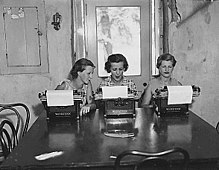
Back Federal Emergency Relief Administration Danish Federal Emergency Relief Administration Spanish Federal Emergency Relief Administration French 連邦緊急救済局 Japanese Федеральная администрация чрезвычайной помощи Russian Federal Emergency Relief Administration SIMPLE 联邦紧急救援署 Chinese
The Federal Emergency Relief Administration (FERA) was a program established by President Franklin D. Roosevelt in 1933, building on the Hoover administration's Emergency Relief and Construction Act. It was replaced in 1935 by the Works Progress Administration (WPA).
During the Hoover Administration, the federal government gave loans to the states to operate relief programs. One of these, the New York state program TERA (Temporary Emergency Relief Administration), was set up in 1931 and headed by Harry Hopkins, a close adviser to then-Governor Roosevelt. A few years later, as president, Roosevelt asked Congress to set up FERA—which gave grants to the states for the same purpose—in May 1933, and appointed Hopkins to head it. Along with the Civilian Conservation Corps (CCC), it was the first relief operation under the New Deal.
FERA's main goal was to alleviate household unemployment by creating new unskilled jobs in local and state government. Jobs were more expensive than direct cash payments (called "the dole"), but were psychologically more beneficial to the unemployed, who wanted any sort of job for self-esteem. From May 1933 until it closed in December 1935, FERA gave states and localities $3.1 billion (the equivalent of $70.8 billion in 2023).[1] FERA provided work for over 20 million people and developed facilities on public lands across the country.
Faced with continued high unemployment and concerns for public welfare during the coming winter of 1933–34, FERA instituted the Civil Works Administration (CWA) as a $400 million short-term measure to get people to work. FERA was shut down in 1935 and its work taken over by two completely new federal agencies, the WPA and the Social Security Administration.
- ^ Trowbridge, D.J. (2016). A History of the United States: 1865 to present. Asheville, NC: Soomo Learning. http://www.webtexts.com/courses/19333-schaller/traditional_book/chapters/1696149-the-new-deal-and-origins-of-world-war-ii-19321939/pages/1428876-the-first-hundred-days?q=FERA
